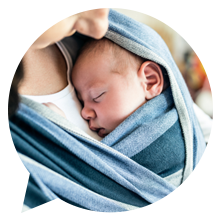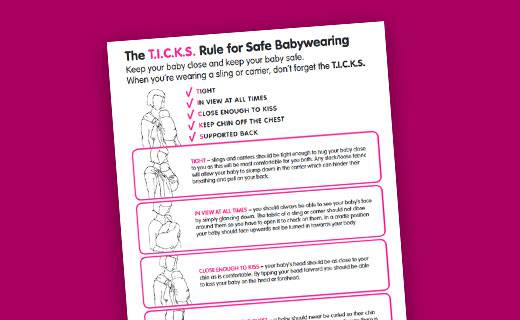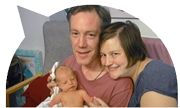Baby slings

What are baby slings and are they safe for your baby?
Baby slings have become an increasingly popular choice for parents, who wish to keep their babies close as part of the bonding process, and for those who practise "attachment parenting".
“Attachment parenting” or “Babywearing” helps to develop and promote secure attachments between the child and their caregivers. The benefits are overwhelming and when carried out safely it is valuable skill to have.
Baby slings are made of soft fabrics that wrap around the chest. They provide comfort and support for the baby and allow the parent to keep their hands free as they go about their everyday tasks. Slings have also been promoted by baby experts as a way to calm fussy babies or as a way for mothers to breastfeed more comfortably. There are a wide variety of carriers available from wraps and ring slings to soft structured carriers and mei tai’s. The number of styles and sizes of carries can be overwhelming. Different slings and carriers will appeal and suit different people so it is important to find one that is best for you and your little one.
The safest method of baby wearing is in a carrier that keeps the newborn baby solidly against the parent's body, in an upright position. Parents should ensure that they keep their baby's chin off their chest, thereby keeping the airway free for breathing.
But RoSPA is concerned about a worrying number of fatalities recorded by parents using certain types of baby slings to carry their children. RoSPA advises parents to be careful with their selection of the type of sling and to be aware that there are risks attached.
A sling's fabric can press against a baby's nose and mouth, blocking the baby's airways and causing suffocation within a minute or two. Suffocation can occur where the baby is cradled in a curved or "C-like" position in a sling, nestling below the parent's chest or near their stomach. Because babies do not have strong neck control, this means that their heads are more likely to flop forward, chin-to-chest, restricting the infant's ability to breathe.
What is the best way of using a baby sling/carrier?

The T.I.C.K.S. rule for safe babywearing
Providing you with a helpful method to keep you and your baby safe
It is vital to be aware of the safety guidelines identified when choosing a carrier and finding one which supports the development of baby's spine, neck and hips. Equally characteristics of a good quality sling or carrier would ensure the child's weight is evenly distributed across the wearer’s shoulders, hips and back.
As with all activities and products that are used for children, it is vital to follow safety advice and manufacturers guides. RoSPA advocates products that keep babies upright and allow parents to see theirbabytheir baby and to ensure that the face isn't restricted. Not all slings are dangerous. A carrier that keeps the newborn baby solidly against the parent's body, in an upright position, is the safest method. Parents should ensure that they keep their baby's chin off their chest, keeping the airways clear for breathing.
The Consortium of UK Sling Manufacturers and Retailers provides the following advice to baby sling wearers: Keep your baby close and keep your baby safe. When you're wearing a sling or carrier, don't forget the T.I.C.K.S acronym:
- Tight
- In view at all times
- Close enough to kiss
- Keep chin off the chest
- Supported back.

Marianne Matthews was celebrating the birth of her first child Eric when, within weeks, he had died after having been carried in a baby sling. Marianne explains what happened.
Read Eric’s Story
What to do if you have concerns about baby slings
If consumers have concerns about any products they have seen advertised, they should contact the Citizens Advice consumer service helpline on 08454 04 05 06.